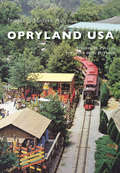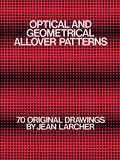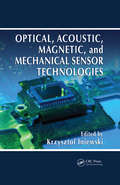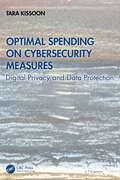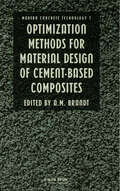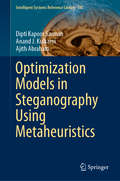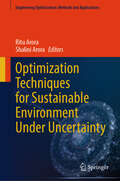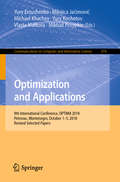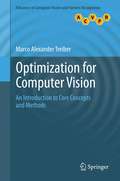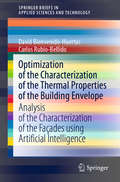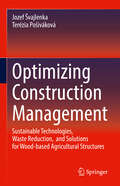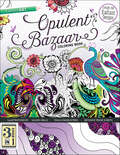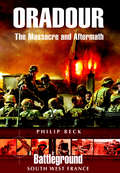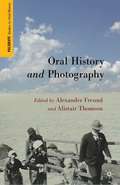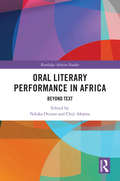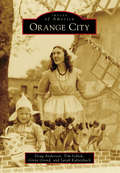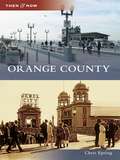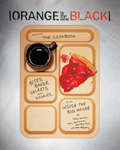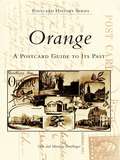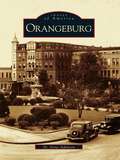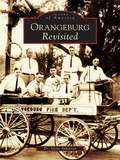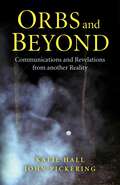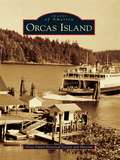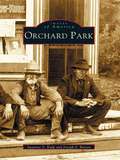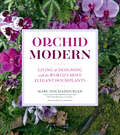- Table View
- List View
Opryland USA (Images of Modern America)
by Ty Herndon Stephen W. PhillipsBy the late 1960s, the Ryman Auditorium--the fifth home of the Grand Ole Opry--was a deteriorating firetrap in a seedy part of Nashville, yet it still attracted thousands of people each weekend to the "show that made country music famous." In an effort to develop an attraction that could sustain a larger Opry all week long, Opryland was born. Opryland USA operated from May 27, 1972, until December 31, 1997, attracting millions of visitors each year and giving many celebrities their first taste of show business. The park consisted of nine areas, dozens of rides, and Broadway-caliber shows featuring live bands and orchestras. As the "Home of American Music," Opryland USA still lives on in the hearts and minds of those who visited its wooded trails, lazy streams, exciting attractions, and toe-tapping performances.
Optical and Geometrical Allover Patterns: 70 Original Drawings (Dover Pictorial Archive Ser.)
by Jean LarcherThe seventy original optical and geometrical allover patterns in this book have been created by Jean Larcher, one of today's leading French graphic artists. He uses circles, squares, curves, lines, and angles in a myriad of ways, creating some of the most fascinating, innovative patterns ever. The dynamic quality of each design is vibrantly clear. Grouped thematically are dazzling circles, popping squares, shimmering angles, emerging dots, receding diamonds, undulating waves. The visual illusions and movement produced are phenomenal, as some patterns recede, others advance, and still others appear to change size. Some are simple; some are startling and complex--but all are intriguing. Because these patterns repeat infinitely in all directions, they may be readily extended for graphics and design work on any scale. The designs may be reproduced just as they are, or cropped, enlarged, repeated, screened, overlaid, or reworked in any manner.
Optical, Acoustic, Magnetic, and Mechanical Sensor Technologies (Devices, Circuits, and Systems)
by Krzysztof IniewskiLight on physics and math, with a heavy focus on practical applications, Optical, Acoustic, Magnetic, and Mechanical Sensor Technologies discusses the developments necessary to realize the growth of truly integrated sensors for use in physical, biological, optical, and chemical sensing, as well as future micro- and nanotechnologies. Used to pick up sound, movement, and optical or magnetic signals, portable and lightweight sensors are perpetually in demand in consumer electronics, biomedical engineering, military applications, and a wide range of other sectors. However, despite extensive existing developments in computing and communications for integrated microsystems, we are only just now seeing real transformational changes in sensors, which are critical to conducting so many advanced, integrated tasks. This book is designed in two sections—Optical and Acoustic Sensors and Magnetic and Mechanical Sensors—that address the latest developments in sensors. The first part covers: Optical and acoustic sensors, particularly those based on polymer optical fibers Potential of integrated optical biosensors and silicon photonics Luminescent thermometry and solar cell analyses Description of research from United States Army Research Laboratory on sensing applications using photoacoustic spectroscopy Advances in the design of underwater acoustic modems The second discusses: Magnetic and mechanical sensors, starting with coverage of magnetic field scanning Some contributors’ personal accomplishments in combining MEMS and CMOS technologies for artificial microsystems used to sense airflow, temperature, and humidity MEMS-based micro hot-plate devices Vibration energy harvesting with piezoelectric MEMS Self-powered wireless sensing As sensors inevitably become omnipresent elements in most aspects of everyday life, this book assesses their massive potential in the development of interfacing applications for various areas of product design and sciences—including electronics, photonics, mechanics, chemistry, and biology, to name just a few.
Optimal Spending on Cybersecurity Measures: Digital Privacy and Data Protection
by Tara KissoonThe aim of this book is to demonstrate the use of business- driven risk assessments to meet the requirements within privacy laws. This book introduces the cyber risk investment model and the cybersecurity risk management framework used within business-driven risk assessments to meet the intent of privacy and data protection laws. This can be used by various stakeholders involved in the implementation of cybersecurity measures to safeguard sensitive data. This framework facilitates an organization’s risk management decision- making process to demonstrate the mechanisms in place to fund cybersecurity measures to meet privacy laws and demonstrates the application of the process using two case studies: CatchMyData and Rapid Cloud Migration. This book also discusses the elements used within the cybersecurity risk management process and defines a strategic approach to minimize cybersecurity risks. Features Aims to strengthen the reader’s understanding of industry governance, risk and compliance practices Incorporates an innovative approach to assess business risk management Explores the strategic decisions made by organizations when implementing cybersecurity measures and leverages an integrated approach to include risk management elements
Optimization Methods for Material Design of Cement-based Composites (Modern Concrete Technology)
by A. M. BrandtProvides a clear, comprehensive introduction to the subject. Different problems of optimization are considered and illustrated with examples. Large sets of new experimental data are presented and discussed.
Optimization Models in Steganography Using Metaheuristics (Intelligent Systems Reference Library #187)
by Ajith Abraham Anand J. Kulkarni Dipti Kapoor SarmahThis book explores the use of a socio-inspired optimization algorithm (the Cohort Intelligence algorithm), along with Cognitive Computing and a Multi-Random Start Local Search optimization algorithm. One of the most important types of media used for steganography is the JPEG image. Considering four important aspects of steganography techniques – picture quality, high data-hiding capacity, secret text security and computational time – the book provides extensive information on four novel image-based steganography approaches that employ JPEG compression. Academics, scientists and engineers engaged in research, development and application of steganography techniques, optimization and data analytics will find the book’s comprehensive coverage an invaluable resource.
Optimization Techniques for Sustainable Environment Under Uncertainty (Engineering Optimization: Methods and Applications)
by Ritu Arora Shalini AroraThe book's objective is to develop mathematical structures that can be applied to real-life problems with sustainable goals. It focuses on the impact of sustainable living on social, economic, and environmental aspects, aiming to create optimization techniques that minimize emissions and maximize green energy. These optimization problems may include sustainable transport, cities, economic development, living, and tourism. The book brings together researchers, academics, and professionals from various fields to find optimal or satisfactory solutions for various environmentally friendly sustainable problems. It aims to achieve this not only with existing optimization techniques, but also with novel approaches such as lexicographic optimization, heuristic approaches, DEA, and genetic algorithms. The goal is to develop practical algorithms and methods applicable to these problems under uncertain circumstances and explore the potential for improving the efficiency of existing algorithms.
Optimization and Applications: 9th International Conference, OPTIMA 2018, Petrovac, Montenegro, October 1–5, 2018, Revised Selected Papers (Communications in Computer and Information Science #974)
by Yury Kochetov Michael Khachay Yury Evtushenko Milojica Jaćimović Vlasta Malkova Mikhail PosypkinThis book constitutes the refereed proceedings of the 9th International Conference on Optimization and Applications, OPTIMA 2018, held in Petrovac, Montenegro, in October 2018.The 35 revised full papers and the one short paper presented were carefully reviewed and selected from 103 submissions. The papers are organized in topical sections on mathematical programming; combinatorial and discrete optimization; optimal control; optimization in economy, finance and social sciences; applications.
Optimization for Computer Vision: An Introduction to Core Concepts and Methods
by Marco Alexander TreiberThis practical and authoritative text/reference presents a broad introduction to the optimization methods used specifically in computer vision. In order to facilitate understanding, the presentation of the methods is supplemented by simple flow charts, followed by pseudocode implementations that reveal deeper insights into their mode of operation. These discussions are further supported by examples taken from important applications in computer vision. Topics and features: provides a comprehensive overview of computer vision-related optimization; covers a range of techniques from classical iterative multidimensional optimization to cutting-edge topics of graph cuts and GPU-suited total variation-based optimization; describes in detail the optimization methods employed in computer vision applications; illuminates key concepts with clearly written and step-by-step explanations; presents detailed information on implementation, including pseudocode for most methods.
Optimization of the Characterization of the Thermal Properties of the Building Envelope: Analysis of the Characterization of the Façades using Artificial Intelligence (SpringerBriefs in Applied Sciences and Technology)
by Carlos Rubio-Bellido David Bienvenido-HuertasThis book is about the optimization of the characterization of the thermal properties of building envelopes, through experimental tests and the use of artificial intelligence. It analyses periodic and stationary thermal properties using measurement approaches based on the heat flow meter method and the thermometric method. These measurements are then analysed using advanced artificial intelligence algorithms.The book is structured in four parts, beginning with a discussion of the importance of thermal properties in the energy performance of buildings. Secondly, theoretical and experimental methods for characterizing thermal properties are analysed. Then, the methodology is developed, and the characteristics and properties of the algorithms used are explored. Finally, the results obtained with the algorithms are analysed and the most appropriate approaches are determined.This book is of interest to researchers, civil and industrial engineers, energy auditors and architects, by providing a resource which improves energy audit tasks in existing buildings.
Optimizing Construction Management: Sustainable Technologies, Waste Reduction, and Solutions for Wood-based Agricultural Structures
by Jozef Švajlenka Terézia PošivákováThis book examines the persistent global problem of low productivity of systems in the construction industry and how it mobilizes research and social efforts to find more efficient procedures and processes associated with production, construction, and operation. The authors discuss increasing the efficiency of construction sites and off-site technologies that present particularly challenging problems in the areas of implementation of lean principles in production procedures, reduction of waste, and improvement of quality and predictability of construction projects. Finally, the book considers the innovation potential for ecological and sustainable construction technologies based on wood and the use of digital tools. It further explores the innovation potential for transforming traditional structural solutions of agricultural buildings using modern, efficient, sustainable, and ecologically sound construction technologies based on wood.
Opulent Bazaar Coloring Book: 3 Books in 1
by Valori Wells55+ intricate designs to color your cares away. Coloring has never been this creative! Get inspired with designs by Paula Nadelstern, Valori Wells, and Bethany Pease Sheets. These illustrations, printed on high-quality, heavyweight paper, are ideal for framing and perfectly suited to coloring with colored pencils, fine tip markers, and even watercolors. There are funky and mesmerizing kaleidoscopic designs, flowery and exotic designs, and freeform doodle designs. Coloring even a few minutes a day can help you relieve stress and infuse much-need creativity into your busy life! • Printed on heavyweight, high-quality uncoated paper with perforated edges for easy framing in an 8" × 10" frame • With a wide variety of designs from three illustrators, there’s something for everyone • Great value: 3 coloring books in 1! (Wholesale minimum: 3 units)
Oradour: The Massacre and Aftermath (Battleground South West France)
by Philip BeckThis WWII pictorial history illustrates a horrifying episode of destruction in Nazi-occupied France. In June of 1944, the Second SS Panzer Division Das Reich was stationed in Southern France until it was called north to help stop the Allied advance. On its way toward Normandy, Das Reich destroyed the French village of Oradour-sur-Glane and massacred its population. The brutal event ranks as one of the most notorious atrocities of the Second World War. While the scars left behind will never fully heal, many believe they should remain as a lesson to future generations. Though a new village was built nearby, President Charles de Gaulle ordered the ruins of Oradour to be preserved as a memorial to the victims. This fully illustrated volume recounts the history and legacy Oradour&’s destruction, complete with photographs of the ruins throughout
Oral History and Photography
by Alexander Freund Alistair ThomsonThis book collects original research essays to explore the diverse uses of photographs and photography in oral history, from the use of photos as memory triggers to their deployment in the telling of life stories. The book's contributors include both oral historians and photography scholars and critics.
Oral Literary Performance in Africa: Beyond Text (Routledge African Studies)
by Nduka Otiono and Chiji AkọmaThis book delivers an admirably comprehensive and rigorous analysis of African oral literatures and performance. Gathering insights from distinguished scholars in the field, the book provides a range of contemporary interdisciplinary perspectives in the study of oral literature and its transformations in everyday life, fiction, poetry, popular culture, and postcolonial politics. Topics discussed include folklore and folklife; oral performance and masculinities; intermediated orality, modern transformations, and globalization; orality and mass media; spoken word and imaginative writing. The book also addresses research methodologies and the thematic and theoretical trajectories of scholars of African oral literatures, looking back to the trailblazing legacies of Ruth Finnegan, Harold Scheub, and Isidore Okpewho. Ambitious in scope and incisive in its analysis, this book will be of interest to students and scholars of African literatures and oral performance as well as to general readers interested in the dynamics of cultural production.
Orange City (Images of America)
by Doug Anderson Sarah Kaltenbach Greta Grond Tim SchlakOrange City was founded in 1869-1870 as a colony of Dutch Americans from Pella. Led by Henry Hospers, the colonists made Orange City the center of Dutch agricultural expansion in northwestern Iowa and farther west. By 1874, the town had railroad connections, was the seat of Sioux County, and had a Dutch-language weekly newspaper that was read in the Netherlands as well as around North America. Hospers, along with others, founded an academy in 1882 to train young people in the classics and the Reformed faith. By the 1930s, the academy was maturing into what is now Northwestern College. The town's populace has never been exclusively Dutch; nevertheless, the Dutch heritage of the settlement has remained central to Orange City's identity. A tulip festival held in 1936 became an annual event that continues to draw tens of thousands of visitors each May. In 1986, a Dutch-front initiative was launched that has transformed much of the town with a distinctive Dutch look.
Orange County
by Chris EptingOrange County was created in 1889. Soon, wilderness evolved into farmlands and communities supported by a year-round harvest of Valencia oranges, lemons, avocados, walnuts, and more. In the 1950s, aerospace and industry expanded here, and today the county boasts more than three million people. This collection features side-by-side historic comparisons of many local institutions, from orange groves to beaches to Disneyland. Chris Epting is the author of 17 books, including Vanishing Orange County and Huntington Beach.
Orange is the new Black Presents: The Cookbook
by Jenji Kohan Tara Hermann Hartley Voss Alex Regnery“A fun read for fans of the Netflix series . . . And don’t worry: These dishes are way better than the food the inmates actually eat on the show” (People). Staffed and run by a band of misfit inmates, the kitchen at Litchfield is in many ways the center of the popular show Orange Is the New Black—a setting for camaraderie, drug smuggling, power struggles, and plot twists. And then there is the food. With sixty-five recipes, twelve sidebars that expand upon the fiction of the show, and sixty photographs from the show featuring favorite characters and memorable moments, Orange Is the New Black Presents: The Cookbook adds new dimensions to any fan’s obsession. The recipes cover three square meals a day, plus snacks/sides, desserts, and drinks. They include Red’s Chicken Kiev, Miss Claudette’s Coconut Cake, and Prison Punch. The sidebars include Taystee’s suggested prison reading list, the recipe for Red’s Homemade Homeopathic Remedies, and a prison glossary. Chock full of in-depth information about the show, including recipe headnotes by the characters, DIY projects that emulate notable props, and prison factoids that help bring the show to life, this cookbook will bring a little piece of Litchfield right into your very own kitchen.
Orange: A Postcard Guide To The Past (Postcard History)
by Don Dorflinger Marietta DorflingerFrom the 1890s through the 1920s, the postcard was an extraordinarily popular means of communication, and many of the postcards produced during this "golden age" can today be considered works of art. Postcard photographers traveled the length and breadth of the nation snapping photographs of busy street scenes, documenting local landmarks, and assembling crowds of local children only too happy to pose for a picture. These images, printed as postcards and sold in general stores across the country, survive as telling reminders of an important era in America's history. This fascinating new history of Orange, New Jersey, showcases more than two hundred of the best vintage postcards available.
Orangeburg
by Dr Gene AtkinsonLocated along the north fork of South Carolina's Edisto River, Orangeburg enjoys an extended, rich heritage dating back to the 1730s when it was created as one of the original inland townships. The first settlers were mostly German and Swiss immigrants who found the area to be the paragon of locales, valuable in fertile soil and abundant wildlife surrounding the river. The city of today has been gently shaped by its landscape and natural life, which called people and industries to experience the benefits of such land. This volume celebrates Orangeburg's history by offering readers a rare find of more than 200 photographs from days gone by, taking them on an adventure through the town's coming of age, from the early days of photography to the 1950s. These images reveal the ways of life long past by showcasing well-known town entities such as the Courthouse Square and the Edisto Memorial Gardens, local businesses like the Orangeburg Hotel, and beloved residents, some of whom were public figures and others better remembered by their families and friends. From early-century churches to the evolution of the county fair, readers will find themselves enthralled by the history that Orangeburg possesses.
Orangeburg Revisited
by Dr Gene AtkinsonOrangeburg, South Carolina, is home to an abundant history, shown in this second volume through over 225 rare images of times gone by. The epitome of the small town, Orangeburg is where friends would gather at the famous Bluebird Theatre or the old soda fountains at a turn-of-the-century drugstore. Residents marveled when the Orangeburg Hotel was constructed in 1909; at the time it was the second tallest structure in all of South Carolina. Marchant Music Co., whose showroom is featured in this volume, recalls the days when everyone gathered around the piano in the parlor. Beauty queens from the old Fall Festival, which preceded the formation of the Orangeburg County Fair, grace the pages of this collection. Even the first motor-powered fire truck makes an appearance, as do the stalwart men who comprised the old volunteer fire departments. Also notable in this volume is the rarely mentioned George H. Cornelson, who had more impact on the city than any other person over the last 130 years.
Orbs and Beyond: Communications and Revelations From Another Reality
by Katie Hall John PickeringThis, the second book in the Beyond Trilogy, expands on John and Katie's experiences and photographs of the orb phenomena covered in their first book. It reveals astounding new photographs and opens up exciting new questions about the whole nature of paranormal phenomena in general. John and Katie's photographs of orbs, angels and other apparitions have brought them into worldwide contact with other experiencers and researchers: it is from this basis that they now take a major step beyond the visible photographable phenomena, and current New Age notions about orbs, to reveal new insights about the paranormal. Could it be that orbs are the indicators of a wider, "beyond" reality? Is the symbology of orbs as images of oneness, drawing our attention to the most important orb of all: the orb of Earth on which we all live? Their ongoing photographs, personal experiences, and the amazing synchronistic events they found themselves part of reveal a conscious, purposeful phenomena that can interact with us as individuals, whoever and wherever we are. This inevitably leads to a spiritual perspective that crosses all religious and cultural boundaries, helping us to see that this one blue orb of Earth on which we all live, is greater than all that divides us! Orbs & Beyond is the vital visual link between Beyond Photography, and the forthcoming Beyond Reality.
Orcas Island
by Orcas Island Historical Society and MuseumOrcas Island, the largest of the 172 islands in San Juan County, lies in the Salish Sea north of Puget Sound. Known as the "Gem of the San Juans" for her shimmering emerald hills bounded by 125 miles of rocky, tree-lined shore, Orcas was home to countless generations of Native Americans before the arrival of its first white settlers, formerly Hudson's Bay men who had hunted on the island, in the late 1850s. An international boundary dispute, popularly known as the Pig War, prevented early pioneers from settling land claims until the dispute was resolved by the German kaiser in 1872. Settlement grew slowly until improved steamship routes and increased commerce brought more tourists to the island. In 1906, Robert Moran built a fabulous estate, Rosario, now a world-class resort. Thousands of visitors have been coming to Orcas Island over the years to explore her forested hills, camp in Moran State Park or stay at one of the many historic resorts, and fish in the pristine waters surrounding this island paradise.
Orchard Park
by Joseph F. Bieron Suzanne S. KulpAttracted by the fertile soil, ample forests, and abundant water, the first pioneer arrived in the Orchard Park area in 1803, making this one of the earliest settlements in western New York. Prominent among the settlers were the Quakers, who built a picturesque meetinghouse that is still in use today. Orchard Park portrays the history of the community through its citizens and their homes and businesses, many of which were at Four Corners. Plank roads and then a railroad and finally a trolley provided opportunities for the community to share in the prosperity of nearby Buffalo in the late 1800s. Old family heritage persists in the names of streets on which century-old houses still stand, connecting yesterday with today.
Orchid Modern: Living and Designing with the World's Most Elegant Houseplants
by Marc Hachadourian“This beautiful book is useful for all of us, novice and experienced orchid lovers alike.” —Martha Stewart, author, entrepreneur, founder of Martha Stewart Living Omnimedia Add the vibrant colors and exotic blooms of orchids to your houseplant haven! It’s easier than you think with the help of Orchid Modern. Marc Hachadourian, the curator of the orchid collection at the New York Botanical Garden, shares his secrets to successfully growing these sometimes finicky houseplants. Besides the basics, you’ll learn his top 120 orchid picks for green and not-so-green thumbs. Ten inspirational, step-by-step projects, including terrariums, a wreath, and a kokedama, provide the confidence to make orchids a thriving, vivid part of your home’s signature style.
